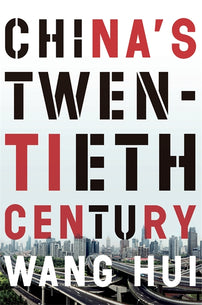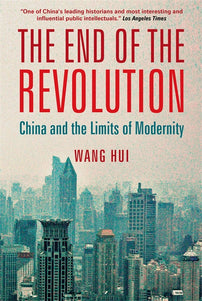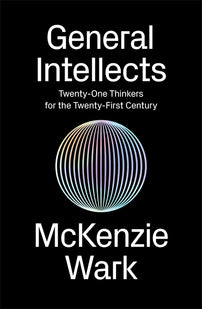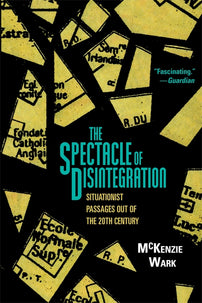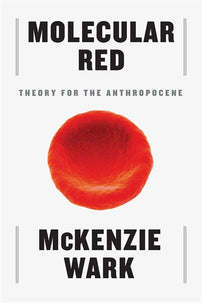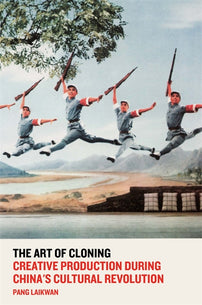Wang Hui on China's Twentieth Century
Continuing his series of additional chapters to General Intellects, McKenzie Wark writes about the recent work of leading Chinese general intellect, Wang Hui.

It no longer seems all that persuasive to criticize China for failing to live up to the model of liberal democracy embodied by the United States. On the other hand, it is disabling to concede too much to the claim of its uniqueness and opacity to the gaze from without. Here Marxists, liberals and conservatives all find themselves in the same bind.
The work of Wang Hui treads a delicate but effective path through this dilemma. In China’s Twentieth Century (Verso, 2016) he holds twenty-first century China to account through the prism of its twentieth century cultural and political innovations.
But this is far from a nostalgic revision to Maoist pieties. It is more a matter of extracting lessons for how culture and politics can be imagined and practiced anew in these times. Wang: “Many show disdain for the political innovations of twentieth-century China, but can China today generate any political processes that can lead to a truly new and different future as it did in 1949?” (152)
China’s return to world history in the twentieth century is one of that period’s defining events, and impossible to capture in mere outline. Both the achievements and the failures of the Chinese Communist Party are on an unprecedented scale. And yet, given that much of the fate of global capitalism now rests in the hands of the Chinese Communist Party, China’s twentieth century cannot be left out of the formation of concepts for thinking and acting in and against these times.
As I noted elsewhere, China is one of the main absences in Eric Hobsbawm’s magisterial multi-volume history of the modern world, but Wang neatly grafts on a new line of historical thought to it. In its effort to modernize, China had to transcend two earlier revolutions, bourgeois democracy and the industrial revolution, what Hobsbawm called the “dual revolution.”
As the twentieth century began, three of the world’s reigning empires came apart: Russia, Austria and Turkey. It was supposed to be the end of the multi-ethnic empire and the birth of a modern political form in which state, nation and people were one. Except in China, where the empire did not fall. The 1911 revolution is the start of China’s short twentieth century, but it did not break up the empire.
The link between the former Qing Dynasty and the 1911 Republic was the doctrine of a sovereignty that resides in the people. But which people? Was China to be an empire, or a nation state? For Wang, “the continuity of sovereignty was always reconstructed, renewed, and never abandoned.” (13) For intellectuals grappling with the problem of change within continuity, this could be parsed as a question of whether China should look more like the expansive Qing Dynasty or the more compact Ming. Overseas Chinese revolutionaries opposed the Qing and wanted the Ming restored, as they saw things through the prism of racial discrimination.
Lenin usually saw multi-ethnic empires as obstacles to be overcome. Unlike Otto Bauer and Rosa Luxemburg, he supported the demand for national liberation, but not as a demand in itself. Modernizing the state through national movements was a step towards modern capitalism, and thence its demise. In the case of China, he was for keeping the empire together. If it fell apart, its border regions would just be exploited by other states.
Should China be a multi-party parliament or revolutionary state? The former project did not make much headway, so many thought that integration required strong executive power. Not the kind espoused by Max Weber that was a neutral function, but rather an administration that could be an integrator. But integration could not be from the top-down alone. Modern China had to learn from the people and mobilize the people.
When the May Fourth Movement kicked off in 1919, it may have looked to Mr. Science and Mr. Democracy as its heroes, but the Great War greatly devalued western modernity in Chinese eyes. China’s revolution would need to find its own form. Politics could no longer be an extension of history as conceived by western modernizers, but had to rupture from it. What was needed was a new kind of politics, a cultural one. “Radical Chinese politics could not have arisen without the desire to break from the nineteenth-century political and economic model.” (44)
Wang uses Antonio Gramsci’s figure of the modern prince to describe a new kind of political party that emerged to fill the role of mobilizing a cultural politics. Both the Nationalists and the Communists attempted it, and shared an approach that combined political integration, social mobilization, and the confrontational style. After they turned on their Communist allies in 1927, the Nationalists abandoned this strategy, to their cost.
The Communists turned class into a voluntarist category, nominating the working class as lead agent of a socialist revolution in a multi-ethnic, agrarian society. This was not just class as structural location — there were comparatively few actual industrial workers in China — but a project of becoming a class. Wang: “The existence of the working class as an appendage of capitalist production — namely, a reified form of labor — is not equivalent to the existence of class politics.” (162)
The Communists attacked the bureaucratic class composed of state officials left over from previous revolutionary efforts. They formed a united front for the liberation of China from foreign oppressors, in which the party organized the working class, and the working class led a class alliance among the people. The category of the people implied a friend/enemy relation.
The Chinese Communists succeeded in putting this theory into practice through some quite unique strategies. Wang explores these through the unlikely lens of the Korean war. It’s a way of keeping China within a geopolitical frame of reference. Mao Zedong linked the Korean war to the Chinese revolution. Its success had revitalized anti-colonial movements, and its gains had to be defended. Mao was keen to disrupt the order outlined at the Yalta and Potsdam Conferences, in which the great powers decided the fate of Asia among themselves. Wang insists on the international as well as the national dimension to the war. It added to the socialist camp’s own internal tensions. It led to the remilitarization of Japan and fueled its economic boom.
Mao (and Zhou Enlai) studied war doctrine and international law during the Japanese occupation. Out of both study and practice came the doctrine of people’s war as a political concept. War is a situation in which to create a new political subject and a politicized army. The war to liberate China from Japanese occupation had led to a new kind of party and army. In the base areas, land reform and military struggle became a mass movement. War could only be won by mobilizing the masses. The regular army was supported by local militias.
The army and the people implies a revolutionary political goal, not just a military one. The people’s war doctrine even extended to the prospect of the atom bomb. Mao argued that even such a powerful weapon could not be decisive. The obsession with weapons technology is the military view, but for Mao politics is at the heart of war. The high tech army is, in his famous phrase, a paper tiger. The people, not the weapons, determine the war. Wang thinks that the American understanding of China was shaped by Korean war, prompting a new discretion. One might add however that the United States never grasped the power of people’s war and has continued to rely on weapons and slaughter to rather mixed results.
During the Japanese occupation, the people’s war was possible because China was neither an imperial nor colonial country, and had a weak and divided ruling class. The Party could establish soviets in its base areas. Here its main political and cultural innovation was the mass line. The Party had to create forms of power that solved people’s everyday problems, to win trust and recruit soldiers. The key issue was land ownership, but the Party also established its own practices regarding gender equality, labor issues, education, trade, even monetary policy. Wang: “The mass line was the basic strategy of people’s war…. [I]t was the Party and its mass line under the conditions of people’s war that created the self-expression of a class and, thus, a class in the political sense.” (140)
The mass line means: all for the masses, all by the masses, from the masses to the masses. The mass line may have connections in Confucian tradition. Attention to rites and music (liyi) and not just statutory measures (zhidu) help create and maintain a kind of regulatory order, what Wang calls supra-representation. Cultural movements come first, and political agents try to steer them. In its revolutionary phase, the Party generated its own approach to culture and theory.
The era of China as a revolutionary state is over, but the form of the current state bears the marks of its origins, although perhaps in the form of an absence: “as China’s public administration has shifted its role from political integrator to a nonpolitical bureaucratic system, the party-state has inevitably suffered a breakdown of representation.” (39) After its victory, the Communist Party tried several times to keep open a path to its renovation through contact with mass politics, but with the catastrophic failure of the Cultural Revolution, this came to an end. State politics fully displaced mass politics and a corresponding depoliticization of the masses. “The Party has submitted itself increasingly to the logic of the state, depriving itself of its essence, which should be a form of political organization and political movement…” (155) Along with the bureaucratization of the party, there’s the marriage of party and capital, the abandonment of category of class.
Wang frames this situation in an interesting way, insisting that the separation of the political form from its social form is actually common to formerly socialist and (formerly) liberal states. In both east and west, party politics becomes fully state politics, with political parties losing their heterogeneous quality. Wang: “… it is the logic of the state that has come to control parties, not political parties that have come to control the state.” (156)
Meanwhile, the media lost their public function. “The large-scale expansion of the media has entailed the contraction of the public sphere, as freedom for the media industry has replaced freedom of speech for the citizens. In China, though the media may appear to be controlled by politics, the political sphere has, in fact, been gradually colonized by the media…. In the political competition between the ‘partified’ media and the traditional party that spawned this media force, the former possesses more political energy and style, and the latter resembles a hapless power apparatus that has lost its ideological function.” (157-158) Curiously, “[t]oday, the forces suppressing citizen’s freedom of speech come not only from the traditional political sphere but from media power that has been corporatized and partified as well.” (167)
The Party still acts as leading entity but no longer represents anyone, but how it might be democratized may yet depend on its distinctive form and history. “Western democracy based on general elections is not the only model of democracy, nor is democracy a merely formal practice.” (160) There might be other criteria: “If a state’s political system has a strong capacity to respond to problems, it indicates that the society contains elements of and a potential for democracy. But because our theories on democracy focus so intently on its political form, they have neglected these substantive potentials.” (300)
In China today, the dynamic of reform includes local experiments as well as from negotiation between center and region. That might be a positive sign. However, with the weakening of political power, state power surrenders to networks of capital’s special interests. “Hence, the crucial problem is not the privatization of state-owned property but freeing state-owned property in China from interest networks centered on capital.” (167)
The People’s Republic has frequently used violence to solve internal tensions. But when Deng Xiaoping put an end to conflict with the party between competing political lines, he may also have weakened its ability to express and negotiate differences in concert with the people. “The cruelty and brutality that appeared during certain line struggles have taught us a heavy lesson — that the CCP most resolve problems on the basis of democracy and law…. Today, the suppression of intellectual debate implemented by political and media power also marks the end of politics.” (168) The Party no longer has much relative autonomy from the state and little independent theoretical space. Politics becomes management.
Wang: “Contemporary China is undergoing a historical process of class restructuring and the suppression of class politics.” (171) This is not to deny the frequency of moments of labor resistance. Worker’s struggles today take the form of strikes, self-organization, or attempts to shorten contracts, or broader local or provincial associations. There’s attention to protecting worker’s rights. In situations of labor shortage, workers ‘fire the boss’ and simply take off for another job. But labor no longer functions as the core of a movement with broad ambitions. The suicide of Foxconn workers in 2010 turned into a discussion about how to reproduce labor power.
The working class used to be a small part of Chinese society, and yet class was the mobilizing form of a revolution. Now China has the largest working class in the world but it is largely absent from the larger political scene. The objective existence of a working class does not in itself generate a labor movement. “That the working class was the leading class was a political assessment rather than a positivist one.” (161)
There are some distinctive features of the working class in China. The rural to urban migration is unusual in that rural workers were supposed to have rights to land from the socialist era. The workers in the state sector were organized in work units (danwei) that were not only instruments of surveillance but also of working class everyday life and social life.
What is called the new poor is a different category. They have higher education but make as much as blue collar workers. Wang: “… they are products of a capitalist economy’s move from manufacturing toward finance capital, from a real economy to a virtual economy.” (188) To the extent that they give rise to a political expression, the new poor are not unlike those that generated Occupy and Gezi Park. They are more active politically than the new workers, but within limitations. “Their inability to satisfy their material desires disillusions them, yet they constantly reproduce a logic of action that exactly fits with consumer society.” (189) They are roughly analogous to what I call the hacker class.
The new poor can be distinguished from the new workers. The latter are mostly rural in origin, although the village home is more a symbol of something lost. They shuttle between dormitory and workshop, human social life reduced to the reproduction of labor power. They lack the security of the old working class. Their struggles as workers take some new forms, such as the foreman system, in which they use labor brokers as the interface with employers.
The old working class linked its fate as a class to that of the whole socialist system, rather than just protecting a class interest or the interests of individual workers. This connection between political and social form is gone. There’s two broad approaches to resolving this problem of the crisis of political representation. Wang sees the notion of importing western-style multi-party democracy as the right-wing option. The left-wing option is to reconstruct political representation within the existing Party. But such a path cannot rely on traditional politics, and must include post-party politics. Wang does not explore this, but these would have to include some that rely on a more recent kind of technical and media infrastructure than the mass print and broadcast infrastructure common to the otherwise rather different eras running from Mao to Deng. If the media seem more powerful than the party then the party needs a new media form.
One could also phrase this as a distinction between the politics of the citizen and the politics of the people. Wang wants to rethink the politics of the people, as one that can include the attention to individual citizen’s right but which does not reduce representation to the representation of the individual. His interest remains in the kind of ‘universality’ central to a class politics in which the working class was supposed to be the leading class in a mobilization of the people.
Wang: “I believe that as China explores transformations in its political form under these new conditions, it needs to draw on the egalitarian legacy of its revolutionary and socialist history. This would allow it to overcome the crisis of legitimacy that has arisen due to the incongruity of political and social forms.” (227) Could there be a new class politics? Perhaps. Modern class politics was always active in the zone where classes overlap, such as between workers and peasants. A class has to look beyond its own interests. But perhaps one might need to ask whether there are new classes who are potential allies or enemies arising out of novel forces and relations of production.
A revival of class politics might begin (but not end) with the issue of equality. Inequality is connected to a lack of public interest, which corresponds to erosion of public policy. Wang agrees with Chantal Mouffe that politics is more about affect than reason. It has to be felt before it can be thought. However, Wang restricts himself to the more conceptual aspect, looking at some established concepts, such as equality of opportunity, equality of outcome, and equality of capabilities.
The central aim of the labor movement is not to redistribute wealth, but to liberate labor power. When in power, it pursued the strategies of common property, converting workers into owners, and socialist production to satisfy needs through the production of use values. This was all sidetracked by a developmentalism that favored the productive forces, giving rise to new hierarchies and monopolies within the socialist state.
Socialist states sought to overcome four inequalities: between workers and peasants, city and country, physical and intellectual labor, and between majorities and ethnic minorities. One could well say that actually existing socialism failed to achieve these goals. But at least it had goals. Now we have the perverse argument that since socialist states failed to achieve their goals we should abandon socialism for a kind of state that seems to have the opposite aim: increasing inequality so as to accelerate the destruction of its natural conditions of existence.
The difference between Marxists and liberals is that liberals pretend to emerge as innocents from history. Still, for those allergic to thinking about what can be extracted from Chinese Communism, Wang also draws on other sources in modern Chinese theory and practice. The book ends with a tantalizing glimpse at what could be made of the work of Zhang Taiyan (aka Zhang Binglin 1868-1936) on the equality of all things. Zhang drew upon the Zhuangzi (aka Chuang-tzu) one of the foundational texts of Daoism, and from Mahayana Buddhism. Starting from the premise that all things have the same nature, and the goal of the universal liberation from suffering of all beings.
For Zhang, the equality of all things was more an ethical doctrine: each thing in the universe is deserving of respect. This does not negate human action, but puts it in continuity with natural forces. Humans exist in both social and natural relations. Nor does it abolish the difference between humans and other things, or among non-human things, but rather considers differences a prerequisite to equality. Inequality between humans and other things is tied to inequality between humans and other humans. Here Wang hints at how this might connect to Marx’s theory of alienation. The exploitation of labor by capital forces a qualitative distinction between two kinds of human which ramifies throughout all the other relations and things in the world.
Each thing possesses its own special quality, and as such all things are equal. But things have to be freed from human conventions to be known as they really are. Zhang based this on a particular method. Things can be known outside of language but only via a process of negation. The uniqueness of things is obscured by convention and habit. The stripping away of habitual names and uses reveals differences as they are.
Wang: “If the equality of humankind is discussed only in terms of the distribution of things, even supposing that such a distribution were carried out in a variety of different ways, it becomes impossible to demonstrate that it is ultimately the form of things qua possessions that is the true source of domination and inequality.” (256) Heading in the direction of the equality of all things is something akin to a politics.
Identity politics stays at the level of names and appearances whereas the equality of all things is a politics of recognition that moves on to singular attributes, but where singularity itself is shared. Difference is a prerequisite to equality. Equality is everything being free from appearances. Zhang rejected that modern theory of knowledge in which the relation between person and thing or even person and person is that between self and other, human and alien. He defined differences actively, and does not take them as essential.
A consequence for Wang is that ecological and cultural diversity are related. He uses this as a basis for rethinking question of minorities and their territories in the context of China. A region is a zone of both natural and human difference, shaped by climate as much as by social forces. The autonomy of a region is not just cultural. But there has been a loss of autonomy in China’s autonomous regions, leading to a hardening of differences of ethnicity or religion. The new businesses, unlike the old socialist organizations, hire Chinese rather than minority workers. Discrimination is masked by meritocracy. Ethic divisions become class divisions. Economic reform disrupts the autonomous regions, leading to conflicts over land.
However, “[u]sing a one-sided viewpoint to combat another one-sided force contributes neither to the protection of ecological and cultural diversity, nor to the achievement of equality.” (273) The counter-policy then has to be to absorb differences into equality and recognize them, while negating differences that emerge in the order of appearances. He is opposed to both the market and to identity, in the name of recognizing the equality of all things.
While Wang is mostly concerned with China, to treat his work as speaking only to the local would simply reproduce an inequality in the world republic of letters. He also offers insights relevant to other locations in geopolitics. His skepticism about the western form of democracy is salutary. It hardly stops western states from imperial and colonial actions. Nor does it stop the exploitation of labor at home or abroad. Nor have the liberal democratic states led an effective response to climate change.
Even when focused on China, Wang is careful to put China into a geopolitics and a geo-humanities that extends far beyond its borders. He does conceive of China as a civilization rather than a nation-state, but is careful not to make the concept of civilization turn on any kind of identity or historical uniqueness. Wang: “civilization is a social paradigm originating from long term relations from diverse origins developed through various forms of mediation.” (279) Here his work can be usefully read alongside Kojin Karatani.
China’s fate, now as in the past, is woven into the world: “if relations between states and the supranational or trans-regional activities engaged in by modern capitalism create an abstract power that tethers all cultural and political factors to economic life, then a ‘trans-systemic society’ would mean the exact opposite of this.” (280) Even the question of class and equality, central to his thinking about China, extends beyond China. “With the international division of labor, disparities between classes and within society as a whole has worsened in China. But these disparities are products of the international division of labor and, as such, aspects of larger systemic contradictions.” (289)
Nor do geopolitical questions stop with labor. “Climate change, the energy issue, cheap labor and even the mechanisms of state oppression are all integral aspects of the new international division of labor. The transfer of global industry also entails the transfer of social contradictions to developing countries.” (292)
Understanding China in the world, and the world including China, “… implies a need to analyze anew the internal contradictions and imbalances within contemporary capitalism in order to uncover and change their driving force and logic.” (164) But perhaps some attention to the forces of production would help us here, particularly the incorporation of information into global infrastructure. The implementation of which is the condition of possibility of the current form of finance, media and technology corporation. Information as a force of production also extends into industrial production itself, which is now governed by its protocols. Perhaps it is a matter of bringing together some lessons from the Mao era of putting politics in command and the Deng era of focusing on the forces of production, but thinking both outside the imperatives of developmentalism.
Wang: “The twentieth century has already become history. Even as China takes up its unprecedented role as factory for the world, what has been called the ‘post-industrial society’ of the West has now reached the ‘end of the era of production,’ according to Baudrillard…” (180) But perhaps China is also in a sense ‘post-industrial.' It runs on a highly advanced and structurally distinct version of what Benjamin Bratton calls the stack, or the layered infrastructure.
Occasionally, Wang offers glimpses of this transformation. Wang: “finance capital has thrown off the constraints of industrial capitalism… the high tech industry is parting ways with traditional industry… Even though we live in an age when class relationships are being reorganized, the revolution in electronic communication technology prevents us from interpreting the character of social mobilizations simply from the vantage point of class politics.” (224-5) Or rather, it calls for renewing the analysis of class itself. The new poor stand in a different relation to commodification than either the old or the new worker. They are the class produced by the commodification of information.
But just as the working class is more than a positivist category, so too is the hacker class, which is what the new poor could become. A class not only in itself but for itself. A class necessarily in alliance with other classes. A class that might point toward a new kind of class dialectic, in that their exploitation is more a matter of surplus information than surplus value. To some extent these are trans-national phenomena. But they do have distinctive characteristics in China, where the build-out of the stack is more tightly connected to the economic mission of the state than is the case in the west, even if in both east and west the stack has a surveillance and policing function. The difference is now between China’s civilization-stack and a western trans-national one, as interdependent as they may be.
[book-strip index="1" style="display"]
